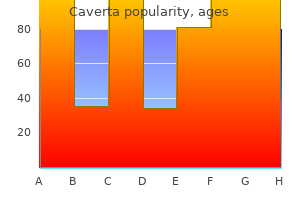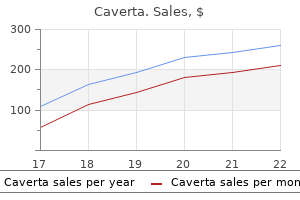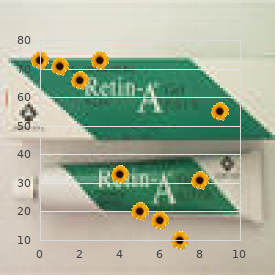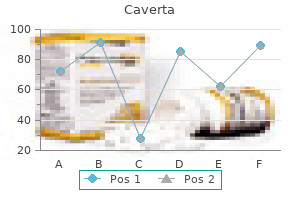Caverta

"Caverta 50mg low cost, erectile dysfunction treatment manila".
F. Hatlod, M.A., Ph.D.
Co-Director, Homer G. Phillips College of Osteopathic Medicine
Speech is nonfluent and poorly articulated whereas language output is agrammatical erectile dysfunction treatment fort lauderdale order 100mg caverta otc. Aphasia and Related Neurogenic Language Disorders xylitol erectile dysfunction 100 mg caverta amex, New York erectile dysfunction depression medication cheap caverta 50 mg without a prescription, Thieme Medical Publishers impotence pronunciation purchase caverta 100 mg with visa. Category-specific naming deficit for medical terms after dominant thalamic/capsular hemorrhage. Anomia for common names and geographical names with preserved retrieval of names of people: A semantic memory disorder. According to Geschwind (1965), disconnection syndromes were higher function deficits that resulted from white matter lesions or lesions of the association cortices; conduction aphasia was usually presented as the prototypal example of a disconnection Aphasia Handbook 77 syndrome. Alternatively, conduction aphasia has also been interpreted as a segmentary ideomotor apraxia. According to this second interpretation, conduction aphasia could be regarded as a verbal apraxia, an ideomotor apraxia impairing the movements required for speaking, or simply as a kinesthetic apraxia of speech. These errors are due mainly to phoneme substitutions and phoneme deletions; they result basically in switches in phoneme manner and place of articulation (Ardila, 1992). Similarities between errors in ideomotor apraxia and conduction aphasia language deficits have been suggested. The three basic characteristics are: (1) fluent conversational language; (2) comprehension almost normal; and (3) significant impairments in repetition. Secondary characteristics include: (1) impairments in naming; (2) reading impairments; (3) variable writing difficulties (apraxic agraphia); (4) ideomotor apraxia; and (5) additional neurological impairments. Bartha and Benke (2003) report that conduction aphasia patients present as relatively homogenic in their aphasic manifestations: severe impairment of repetition and fluent expressive language functions with frequent phonemic paraphasias, repetitive selfcorrections, word-finding difficulties, and paraphrasing. Language comprehension Aphasia Handbook 78 (auditory and reading) is only mildly impaired. Basic language characteristics in conduction aphasia Some neurological abnormalities can be found in conduction aphasia (Table 5. Articulation is usually normal, but frequently somatosensory defects (such as hypoesthesia, difficulties for localizing tactile stimuli, etc. Ideomotor apraxia is generally found, and even some authors have proposed that conduction aphasia could be interpreted as a segmentary ideomotor apraxia. A significant amount of phonological paraphasias are observed and from time to time, verbal paraphasias are also found. Sometimes it is impossible to produce the word during repetition, but not in spontaneous language. Writing defects (afferent motor agraphia, according to Luria, 1977) are variable in severity; usually literal paragraphias (parallelizing the phonological paraphasias) are found. In cases of extended damage in the left parietal lobe, an apraxia for writing (apraxic agraphia) can be found (see Chapter 7: "Agraphia") the possibility of several mechanisms, each of which is capable of giving rise to deficient repetition, led to the postulation of two different forms of conduction aphasia named as efferent conduction aphasia and afferent conduction aphasia (Kertesz, 1985); or reproduction and repetition (Shallice & Warrington, 1977); or supra- and infrasylvian (Axer et al. The efferent-reproduction type involves the phonemic organization and representation of words and is correlated with parietal and insular damage, whereas the afferent-repetition conduction aphasia involves short-term memory defects and affects the repetition of large strings of material. Of note, language repetition impairments are not restricted to conduction aphasia and can be observed in different aphasia syndromes. It was concluded that, depending on the specific repetition task, errors may be evident or unnoticed in a particular aphasic group. The authors proposed that different mechanisms may underlie repetition deficits in aphasia: limitation of auditory-verbal short-term memory, difficulties at the level of phonological production, impairments in phoneme recognition, and semantic and syntactic comprehension (Table 5. Aphasia Handbook 80 Boston Diagnostic Aphasia Examination Words High-Probability Low-Probability Transcortical motor 98. The arcuate fasciculus is the main part of a larger tract located lateral to the corticospinal tract, known as the superior longitudinal fasciculus. The really crucial question becomes: Is it invariably the arcuate fasciculus affected in cases of conduction aphasia Bernal and Ardila (2009) observed that transferring of speech information from the temporal to the frontal lobe uses not only one but two different streams (the arcuate fasciculus and an indirect pathway passing through the inferior parietal cortex); and furthermore, conduction aphasia can be found in cases of cortical damage without subcortical extension (Quigg, Geldmacher & Elias,2006). Together, these observations strongly suggest that the arcuate fasciculus is not required for repetition, but it could have a subsidiary role in it. In general, it is considered that extrasylvian (transcortical) sensory aphasia includes the following elements: (1) Good repetition (the patient repeats words and sentences presented by the examiner, regardless if they are incorrect and even in a foreign language); (2) Fluent conversational language; (3) Significant amount of verbal paraphasias and neologisms; and (4) Empty speech.


The appearance of this arrangement may be enhanced with a red-free filter erectile dysfunction at age 31 cheap 50mg caverta with visa, and can be well delineated using either fluorescein or indocyanine green angiography impotence forums 100mg caverta with amex. Pathophysiology Choroidal folds are not a diagnosis erectile dysfunction foods that help generic 100mg caverta overnight delivery, but a finding that must be investigated in every presentation in order to ascertain what precipitating cause(s) may exist erectile dysfunction remedies fruits order caverta 50 mg on line. Hypotony secondary to an open globe combined with loss of ocular contents (aqueous, vitreous, lens) are thought to be a cause of choroidal folds. Dilated and hyperpermeable choroidal vessels may result in focal retinal pigment epithelium alterations that can progress to choroidal neovascularization or chronic central serous chorioretinopathy. Rather, choroidal folds typically occur in cases where hyperopia is acquired when the globe is foreshortened. There exists a wellknown, largely benign syndrome involving acquired hyperopia and choroidal folds, occurring both with and without increased intracranial hypertension. Studies of astronauts following prolonged space travel have identified characteristic changes including globe flattening, hyperopic shift, choroidal fold development and increased intracranial pressure. It is hypothesized that these optic nerve and ocular changes may result from intracranial fluid shifts brought about by prolonged microgravity exposure. The management is identifying and eliminating the underlying cause, thereby causing them to resolve as the source is eliminated. Unilateral choroidal folds are associated with a higher frequency of orbital disease such as retrobulbar mass lesions. Echography or neuroimaging will identify retrobulbar mass lesions, sinus expansion and muscle enlargement in thyroid eye disease. Lumbar puncture will reveal if intracranial pressure is elevated with a diagnosis of pseudotumor cerebri. Choroidal folds arising from VogtKoyanagi-Harada disease can be managed with systemic steroids. Clinicopathologic correlation of choroidal folds: secondary to massive cranioorbital hemangiopericytoma. Management of hypotony maculopathy and a large filtering bleb after trabeculectomy with mitomycin C: success with argon laser therapy. Profound hypotony maculopathy in a first episode of bilateral idiopathic acute anterior uveitis. Bilateral choroidal folds and optic neuropathy: a variant of the crowded disk syndrome Ethmoid sinus osteoma presenting as epiphora and orbital cellulitis: case report and literature review. Analysis of choroidal folds in acute Vogt-Koyanagi-Harada disease using highpenetration optical coherence tomography. Detection of choroidal folds in patients with Vogt-Koyanagi-Harada disease by retromode scanning laser ophthalmoscopy. Choroidal folds in acute-stage Vogt-Koyanagi-Harada disease patients with relatively short axial length. Optical coherence tomography in monitoring of choroidal folds after surgical excision of ethmoidal myxoma. Optic disc edema, globe flattening, choroidal folds, and hyperopic shifts observed in astronauts after long-duration space flight. Optic nerve fenestration in a patient with the syndrome of acquired hyperopia and choroidal folds. Long term follow-up of persistent choroidal folds and hyperopic shift after complete removal of a retrobulbar mass. Lens subluxation commonly induces visual disturbance, which may range in severity from mild to extreme. Monocular diplopia is a common complaint, particularly when the crystalline lens bisects the pupil. Open-angle glaucoma is also possible in cases of crystalline lens subluxation, with the primary mechanisms being traumatic damage to the anterior chamber angle. Using direct illumination, this is seen as an intrapupillary dark crescent against the convex edge of the displaced lens; with retroillumination, the dark crescent is replaced by a red reflex crescent that appears brighter than the adjacent lens. Dislocation (not true subluxation) of the lens may be up and out, down and in, down and out, nasal or temporal, or the lens may be completely displaced into the posterior or anterior chamber.

Sometimes the student will have to make the diagnosis from clinical clues and then apply his or her knowledge of the consequences of the pathologic process erectile dysfunction in early 30s generic caverta 100 mg. For example erectile dysfunction drugs side effects cheap caverta 50 mg online, "A 26year-old male complains of severe throbbing headache with clear nasal drainage erectile dysfunction medication shots discount 100mg caverta otc. However erectile dysfunction from diabetes generic 100mg caverta with mastercard, if the phrase is added, "The patient is noted to have dilated pupils and tachycardia," then he is likely a user of cocaine. Understanding the types of consequences also helps the clinician to be aware of the dangers to a patient. Cocaine intoxication has far different consequences such as myocardial infarction, stroke, and malignant hypertension. To answer this question, not only do clinicians need to reach the correct diagnosis and assess the severity of the condition, but they must also weigh the situation to determine the appropriate intervention. For the student, knowing exact dosages is not as important as understanding the best medication, route of delivery, mechanism of action, and possible complications. It is important for the student to be able to verbalize the diagnosis and the rationale for the therapy. An exception to this rule is in an emergent situation such as respiratory failure or shock when the patient needs treatment even as the etiology is being investigated. There are four steps in the clinical approach to the neurology patient: making the diagnosis, assessing severity, treating based on severity, and following response. There are seven questions that help to bridge the gap between the textbook and the clinical arena. Mini-Mental State: a practical method for grading the state of patients for the clinician. It involves both hands and affects his handwriting, drinking coffee and other liquids with a cup, and general work that requires manual dexterity. He is otherwise healthy, although he feels his balance is not quite as good as it used to be. On examination he has a rather regular tremor of approximately 8 cycles per second (Hz) with his hands extended and also on fingernose-finger maneuver. His tone is normal although, when performing voluntary movements with one hand there is a "ratchety" quality felt in the tone of the contralateral arm. The cogwheel effect when testing muscle tone (especially in the arms) without increased tone. Lead-pipe rigidity-The hypertonicity felt in a parkinsonian limb throughout the range of movements of a joint. Physiological tremor-This is a very-low-amplitude fine tremor (between 6 Hz and 12 Hz) that is barely visible to the naked eye. It is present in every normal individual during maintaining a posture or movement. Neurologic examination results of patients with physiologic tremor are usually normal. Enhanced physiological tremor-This is a high-frequency, lowamplitude, visible tremor that occurs primarily when a specific posture is maintained. Clinical Approach Essential tremor is the most common of the many movement disorders. It is considered a monosymptomatic disease; that is, it causes tremor and nothing else. Essential tremor often begins gradually, and sometimes it appears during adolescence. The most common sign is a trembling, up-and-down movement of the hands, although the arms, legs, head, and even the tongue and voice box (larynx) can also be affected. Tremors usually occur only when the patient engages in a voluntary movement, such as drinking a glass of water, writing, or threading a needle. Actions requiring fine-motor skills-using utensils or small tools, for example- can be especially difficult. Fatigue, anxiety, and temperature extremes make the signs worse, but tremors usually disappear asleep or at rest.



Department of Health and Human Services erectile dysfunction education cheap 50 mg caverta mastercard, Office of the Assistant Secretary for Planning and Evaluation girl experiencing failure in school and/or low self-esteem erectile dysfunction pump on nhs discount 50 mg caverta amex, making her vulnerable to exploitation (Harway & Liss prostaglandin injections erectile dysfunction buy caverta 100mg, 1999) erectile dysfunction guide purchase caverta 100 mg on-line. Another risk factor that emerges for youth at risk for exploitation through prostitution is the loss of a parent through death, divorce, or abandonment. For example, in two separate studies of adolescent girls involved in prostitution, a third of the sample had a deceased mother (Norton-Hawk, 2002; Raphael & Shapiro, 2002). One study in Canada of 47 women in prostitution found that 64 percent had been involved in the child welfare system, and of these, 78 percent had entered foster care or group homes (Nixon, Tutty, Downe, Gorkoff, & Ursel, 2002). The themes of trauma, abandonment, and disruption, begun in childhood, are central to the narratives of adolescent girls trafficked into commercial sexual exploitation. Girls describe having had a profound sense of being alone without resources: "They [the women and girls] described their isolation, lack of connectedness, and feelings of separation as the single most important factor in making them vulnerable to prostitution to begin with. The prostitution of boys is not as visible as that of young girls (McKnight, 2006). According to Flowers (1998), boys primarily sell their bodies to "survive financially, explore their sexuality, and/or make contact with gay men," with money a major motivator to continue prostituting. Young prostituted males are also more likely to be involved in criminal or delinquent behaviors in addition to prostitution (Flowers, 1998); however, they are arrested much less frequently (McKnight, 2006). McKnight also states that boys are more likely than girls to leave home due to a feeling of being unwanted or misunderstood regarding their sexual orientation. Similar to girls, however, most boys exploited through prostitution come from dysfunctional homes and a large percentage have been the victim of some kind of abuse in the past (Flowers, 1998). Girls who run from their homes, group homes, foster homes, or treatment centers, are at great risk of being targeted by a pimp (or trafficker) and becoming exploited. Research consistently confirms the correlation between running away and becoming exploited through prostitution. Researchers have found that the majority of prostituted women had been runaways; for example, 96 percent in San Francisco (Silbert & Pines, 1982), 72 percent in Boston (Norton-Hawk, 2002) and 56 percent in Chicago (Raphael & Shapiro, 2002). Among prostituted youth (both boys and girls), up to 77 percent report having run away at least once (Seng, 1989). Experts have reported that within 48 hours of running away, an adolescent is likely to be approached to participate in prostitution or another form of commercial sexual exploitation (Spangenberg, 2001); however, no definitive published research substantiates this claim. Like girls, boys exploited through prostitution are most often runaways or throwaways (Flowers, 2001; Lankenau et al. For example, one study found that two-thirds of males exploited through prostitution had run away from home prior to becoming involved (Allen, 1980). While many of the factors leading to a young person leaving home are similar for boys and girls, it is estimated that between 40 and 50 percent of boys exploited through prostitution had been thrown out of their homes because of sexual identity issues (Earls & David, 1989; Seattle Commission on Children and Youth, 1986). Department of Health and Human Services, Office of the Assistant Secretary for Planning and Evaluation Regardless of their sex, when minors leave their homes, it is to protect themselves, often because they view living on the streets as either less dangerous or no more dangerous than staying at home (Hyde, 2005; Martinez, 2006). Once on the street, homeless youth are at risk for being victimized because they lack the funds, interpersonal and job skills, and support systems necessary to survive on their own (Martinez, 2006). Having often come from chaotic families, runaways tend to lack strategies for problem solving, conflict resolution, and meeting basic needs such as food, clothing, and shelter (Martinez, 2006; Robertson & Toro, 1999; Whitbeck, Hoyt, & Yoder, 1999). Some minors turn to substance abuse, crime, and "survival sex" to meet their basic needs (Greene, Ennett, & Ringwald, 1999; Riley, Greif, Caplan, & MacAulay, 2004; Robertson & Toro, 1999). Furthermore, exposure to the dangers of the street makes them more visible and vulnerable to traffickers, and their risky lifestyles and routines put them at greater risk of being victimized (Kipke, Simon, Montgomery, Unger, & Iversen, 1997; MacLean, Embry, & Cauce, 1999; Tyler, Cauce, & Whitbeck, 2004). Most runaway/throwaway youth are likely to run to and congregate in urban areas, so it is not surprising that there is general consensus that a greater percentage of minors are exploited in the U. However, an increase in minor arrests in suburban counties/areas and rural areas has experts speculating that the increase is indicative of an expansion of prostitution beyond city limits (Flowers, 2001). While these data are somewhat outdated, anecdotal evidence from service providers indicates that this trend continues (A. However, further research is needed to determine whether the increase in suburban arrests is due to better identification or an actual increase in incidence. Needs of International Victims An examination of the services provided to international victims of human trafficking (adults and children) reveals emergency, short-term, and long-term needs (Caliber Associates, 2007; Clawson, Small, Go, & Myles, 2004). Some victims initially may present to a service provider with basic needs for safety, housing, food, and clothing.
